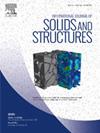Flexoelectric metamaterials design based on anti-trichiral structure
IF 3.4
3区 工程技术
Q1 MECHANICS
International Journal of Solids and Structures
Pub Date : 2025-03-20
DOI:10.1016/j.ijsolstr.2025.113347
引用次数: 0
Abstract
Flexoelectricity is characterized by the polarization in response to strain gradients. Since the flexoelectric effect is not restricted by crystalline symmetry and exists in all dielectrics, flexoelectric metamaterials offer a promising approach to achieve apparent piezoelectricity in non-piezoelectric materials through structural design. In this work, a bending-dominated anti-trichiral structure is utilized to design a flexoelectric metamaterial. Theoretical analysis and finite element simulations reveal that external axial compression enable the rotation of solid cylinders and consequently leads to a bending deformation in ligaments. The superposition of the flexoelectric charges of the bent ligaments makes the anti-trichiral structure exhibit apparent piezoelectricity. The effective piezoelectric coefficient is theoretically predicted to exceed 3000 pC/N by optimizing the structural parameters, such as reducing the ligament thickness to hundreds of micrometers. Resin- and unpoled lead zirconium titanate-based metamaterials are fabricated by 3D printing and laser cutting, respectively. Both specimens exhibit apparent piezoelectricity subjected to axial dynamic loads. The measured piezoelectric coefficient is consistent with the theoretical predictions, verifying the design strategy. This work offers insights into the design of flexoelectric metamaterials and highlights the potential of mechanical metamaterials for high-performance sensing and energy harvesting applications utilizing the flexoelectric effect.
基于反三手性结构的柔性电超材料设计
挠性电的特点是对应变梯度的极化响应。由于挠曲电效应不受晶体对称性的限制,并且存在于所有介质中,因此通过结构设计,挠曲电超材料为在非压电材料中实现表观压电提供了一条很有前途的途径。在这项工作中,利用弯曲主导的反三手性结构来设计柔性电超材料。理论分析和有限元模拟表明,外部轴向压缩使固体圆柱体旋转,从而导致韧带弯曲变形。弯曲韧带的挠性电荷的叠加使反三手性结构表现出明显的压电性。通过优化结构参数,如将韧带厚度减小到数百微米,理论上预测有效压电系数将超过3000 pC/N。树脂基和非极性钛酸铅锆基超材料分别通过3D打印和激光切割制备。两种试样在轴向动载荷作用下均表现出明显的压电性。实测压电系数与理论预测一致,验证了设计策略。这项工作为柔性电超材料的设计提供了见解,并强调了机械超材料在利用柔性电效应的高性能传感和能量收集应用中的潜力。
本文章由计算机程序翻译,如有差异,请以英文原文为准。
求助全文
约1分钟内获得全文
求助全文
来源期刊
CiteScore
6.70
自引率
8.30%
发文量
405
审稿时长
70 days
期刊介绍:
The International Journal of Solids and Structures has as its objective the publication and dissemination of original research in Mechanics of Solids and Structures as a field of Applied Science and Engineering. It fosters thus the exchange of ideas among workers in different parts of the world and also among workers who emphasize different aspects of the foundations and applications of the field.
Standing as it does at the cross-roads of Materials Science, Life Sciences, Mathematics, Physics and Engineering Design, the Mechanics of Solids and Structures is experiencing considerable growth as a result of recent technological advances. The Journal, by providing an international medium of communication, is encouraging this growth and is encompassing all aspects of the field from the more classical problems of structural analysis to mechanics of solids continually interacting with other media and including fracture, flow, wave propagation, heat transfer, thermal effects in solids, optimum design methods, model analysis, structural topology and numerical techniques. Interest extends to both inorganic and organic solids and structures.

 求助内容:
求助内容: 应助结果提醒方式:
应助结果提醒方式:


